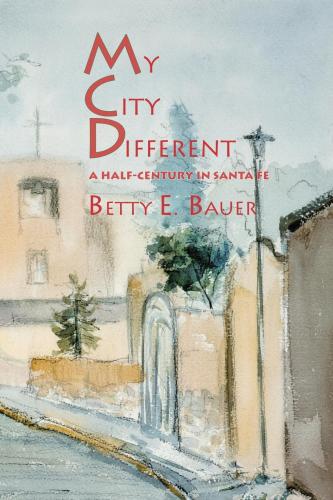My City Different. Betty E. Bauer
MY
CITY
DIFFERENT
MY
CITY
DIFFERENT
A HALF-CENTURY IN SANTA FE
BETTY E. BAUER
On the cover:Watercolor of East DeVargas Street, Santa Fe, by Carulo 1981
© 2004 by Betty E. Bauer.
All rights reserved.
No part of this book may be reproduced in any form or by any electronic or mechanical means including information storage and retrieval systems without permission in writing from the publisher, except by a reviewer whomay quote brief passages in a review.
Sunstone books may be purchased for educational, business, or sales promotional use. For information please write: Special Markets Department, Sunstone Press, P.O. Box 2321, Santa Fe, New Mexico 87504-2321.
Library of Congress Cataloging-in-Publication Data:
Bauer, Betty E., 1928–
My city different: a half-century in Santa Fe / by Betty E. Bauer.
p. cm.
ISBN: 0-86534-421-3 (pbk.)
1. Bauer, Betty E., 1928– 2. Santa Fe (N.M.)—Biography.
3. Journalists—New Mexico—Santa Fe—Biography.
I. Title.
F804.S253B38 2004
978.9′56053′092—dc22
2004000893
SUNSTONE PRESS / POST OFFICE BOX 2321 / SANTA FE, NM 87504-2321 / USA
(505) 988-4418 / ORDERS ONLY (800) 243-5644 / FAX (505) 988-1025
DEDICATED TO ALL THOSE WHO CONTRIBUTED TO MY LIFE AND TIMES IN SANTA FE, NEW MEXICO
This is a glimpse of Santa Fe,
New Mexico as I knew it—
and a few of the people who made it so
INTRODUCTION
The first Spaniard to travel the long, hard journey from Mexicointo the land that became New Mexico was Francisco Vasquez de Coronado, a gentleman adventurer in search of gold. He made the trip in 1540-42 and found only primitive Indian adobe dwellings which, in the sun’s reflection, may have resembled the golden Cities of Cibola to a more imaginative fellow, but generated only profound disappointment in Coronado.
Half a century later, Don Juan de Oñate set forth from the district of Chihuahua, Mexico in New Spain and founded the first settlement slightly north of present-day Santa Fe on the Rio Grande. He was Governor of this new land until 1608, when the Viceroy in Mexico City, displeased with Oñate’s performance, forced him to resign and sent Don Pedro de Peralta to replace him.
Peralta founded the city of Santa Fe in 1610 as the capital of New Mexico, and proceeded to lay the town out in accordance with established Spanish custom.
Laid out in a Roman grid pattern, the plaza was the center or hub with all streets emanating from it. The streets, having been laid out in the first part of the 17th century, are narrow but straight. They form boxes of ever-increasing size, fanning out with regularly-spaced, parallel streets going north and south, intersecting similarly-laid streets flowing east to west, so that there is a uniformity to the center of town which is lacking in the outlying areas. Added later, the early residential streets were formed haphazardly and are inclined to wind and weave around every which way, making it easy for a newcomer to get very lost.
The small Spanish town thrived until the 1680’s when the Indians of the many surrounding pueblos became fed up with their treatment by the Spaniards, particularly the Franciscan Priests, and revolted. They took the town in a bloody battle and held it until 1693 when Don Diego de Vargas marched on the city and, in a bloodless reconquest, re-established the seat of government and Spain’s dominance over the new land.
Mexico declared its independence from Spain in 1821 and became a Republic in 1824. New Mexico became a part of the Republic of Mexico until, as a result of the Mexican War of 1846, the United States acquired most of New Mexico. The rest was redeemed through the Gadsden Purchase in 1853. Union troops recaptured the territory after Confederate troops held it briefly during the Civil War. Thus, four flags have flown from Santa Fe’s venerable Palace of the Governors.
For two-thirds of a century, New Mexico remained a territory. Finally, in 1912, it was the last of the contiguous states to be admitted to the Union.
Santa Fe is in the northernmost part of the state and, at 7,000 feet, lies at the base of the Sangre de Cristo Mountains which rise to more than 12,000 feet. It is high desert country with broad vistas, mountains in every
